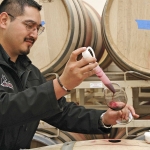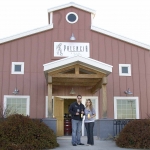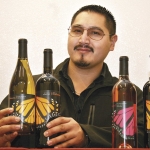Victor Palencia dreams big. He’s already fulfilled his dreams of being a winemaker and winery owner, before turning 30, and is now focusing on reaching Hispanic consumers with his wines.
Palencia launched his own winery last fall in Walla Walla, Washington, about a decade after he attended Walla Walla Community College’s viticulture and enology program. A spring grand opening is planned for the upstart winery called Palencia Wine Company, located in one of five wine incubators at the Walla Walla airport.
“My long-term goal in life was to be a winemaker,” he said. “When I was young, I thought it was just a pipe dream.”
Palencia began living that dream before he was old enough to legally taste wine. He made national news in the New York Times, being featured in a story about his underage role as assistant winemaker at Willow Crest in Prosser, Washington. Since 2008, he’s been head winemaker at J & S Crushing and winemaker for Jones of Washington winery. J & S, a custom crush facility, is one of the largest wineries in the state. The Jones winery is housed within the J & S winery.
“I always thought owning my own winery was out of the question,” Palencia said. “It was when I worked at Willow Crest after college that I realized I wanted to own a winery someday. But it was always just a dream.”
Palencia produced 600 cases of wines for the launch of his new winery and will produce about 1,200 cases from the 2013 crush—all without any bank loans, a feat in itself. “I still have to pinch myself to know I’m not dreaming and remind myself that I’m ‘the owner,’” he said.
Journey
Palencia’s winemaking path was not an easy one. He was brought to the United States around the age of two years old when his family left Mexico to start a new life. The family settled in Yakima Valley, and his father worked as a farmworker in crops like mint and corn, later shifting to vineyards and orchards. Today, his father is a vineyard foreman. The family gained legal status in the late 1980s, thanks to immigration reform legislation passed in 1982.
As a teenager, he followed in his father’s footsteps, working in the vineyards. At 16, he worked in the wine cellar for Dave Minick at Willow Crest, doing a variety of jobs around the winery.
“When I was young, I wanted to be like my father and work with grapes,” said Palencia, adding that his home was in the middle of a vineyard. However, his mother was not thrilled about work in the winery. “She thought I’d become an alcoholic if I was a winemaker.”
Palencia, who has seven siblings, was the first in his family to attend college. He received a scholarship to attend the Walla Walla viticulture and enology program and graduated in 2005. While at Walla Walla College, he interned for top wineries, including Saviah Cellars and Basel Cellars.
“I grew up in very humble surroundings,” he said. “I went to college in part to encourage my siblings and cousins to reach for their dreams.”
In less than a decade, Palencia became head winemaker at the custom crush facility in Mattawa owned by Jack Jones and Dick Shaw. He joined J & S as the custom crush project broke ground. Last year, the winery processed more than three million gallons of wine.
J & S and Jones of Washington are his first priority, he said. “Those two wineries are my full-time, day job, and I greatly appreciate what they’ve [Jones and Shaw] done for me.” Initially, Palencia Winery will be a custom-crush client at J & S, which allows him to use equipment at the Mattawa facility and keep his overhead low. As his winery grows, his plans are to have all winemaking equipment at the Walla Walla location.
Under terms of the incubator lease, Palencia has six years before he must move the winery out of the airport facility.
Palencia wants his wine brand to tell about his Mexican roots and his story of hard work, inspiration, and dreams. His upper-tier label, called Palencia Winery, features a line drawing of his father and a shovel. “For a farmer, a shovel is the key to the land and represents hard work,” he said. “Farmers have a love of the land and hard work.”
The initial release for Palencia Winery is a Cabernet Sauvignon made from Red Mountain grapes and Sauvignon Blanc wine from Yakima Valley. The wines retail for $40 and $18, respectively.
His lower-tier brand is Vino la Monarcha, or Monarch wine, named after the Monarch butterfly that begins its massive migration in his home state of Michoacán and flies to Canada. “I want the wine to inspire people to go for it and let their dreams fly,” Palencia said. “When I sell a bottle of Monarcha wine, I picture that the butterfly has landed.”
Monarcha wines include a Chardonnay, dry Pinot Noir rosé, a Merlot-based blend, and a Cabernet Sauvignon-based blend. Some wines have a right butterfly wing, some a left. When put together, the wings form a complete butterfly. Monarcha wines retail for $14 per bottle.
Palencia is releasing two new wines this spring. One is called Albañil, which means mason worker, the job his father had in Mexico. Albañil is a Rhone blend of Grenache, Mourvédre, and Syrah. The other wine is made from the white variety Alvarinho.
One of Palencia’s goals for his winery is to reach the Hispanic market. Data shows that Millennial wine drinkers—those born from the 1980s to 2000s—are a key market segment fueling the nation’s increased wine consumption.
“A lot of those Millennials are Latinos that are drinking Gallo’s Moscato sweet wines,” he said. “I want to reach that market and encourage them to drink local wines.”
He plans to use nontraditional ways to tap into the Latino market—radio advertising, social media, promoting the use of Palencia Winery gift cards, supplying wines to local restaurants via kegs, and pairing his wines with Mexican food, such as carnitas with Cabernet Sauvignon, Chardonnay with tomatillo salsa, and Sauvignon Blanc with ceviche.
“My mother gave me the confidence to dream, and my father showed me hard work,” he said, both traits that he has adopted. “I’m like a child living in a field of dreams.” •




Leave A Comment